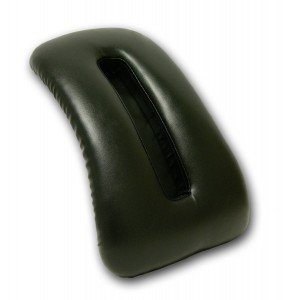We know that there is a normal diurnal variation of spinal height in a person throughout the day. From a physiological point of view, the normal lumbar lordosis flattens and the intradiscal pressure increases. It is believed that the amount of height loss/gain is proportional to increasing or decreasing compressive loads on the spine.
From the study “Spine Height and Disc Height Changes As the Effect of Hyperextension Using Stadiometry and MRI” it was tested to see if going through with the hyperextension exercises (aka supine hyperextended posture) results in any substantial amount of increase in the disk height and overall height. The hyperextension method involves an inflatable cushion placed under the lumbar spine and the person just lying down on it. The result is supposed to be the same effect as traction, which is to decompress the back, specifically the lower back area since the inflatable cushion is place in the lumbar region of the column. To make sure that the change in spinal height was real, a stadiometer was used to be extremely accurate. In addition, a MRI was done to check how the thickness of the disks changed after using the cushion.
The results from the study show that nearly everyone in the study increased their spinal height even after 10 minutes of use of the supine hyperextended posture.
- Height gain after 10 minutes in the supine hyperextended posture – 5.234 mm ± 1.798 mm
- Height lost during the seated posture before hyperextension – 5.030 mm ± 2.266 mm
So we see that with only 10 minutes of lieing down on the ground and not having to exert too much effort and energy, we can increase our height by over half a cm on average. That is around 1/4th of an inch, which is very good for only 10 minutes of work. The conclusion is that the supine hyperextension posture would work to decrease the amount of height loss due to the load placed on discs.
Note: Another study showed that the optimal time and angle combination was 20° for 20 minutes, as it resulted in the largest recovery and also remained for a relatively long period of time. This would give possibly the optimal positioning and timing for best results, not just for height increase but also pain reducing and discomfort removal.
The supine hyperextension posture is basically traction, since they operate on the same principle to get the results desired.
So would traction work? I would guess that it would, but the results would be not as great as hoped for.
Many months ago I had written a very short post showing the different types of traction machines that are being sold on the internet. The post was “Increase Height And Grow Taller Using A Back Vertebrate Traction Device, Cervical, Lumbar, And Thoracic”
The post was not that informative or useful by itself since all I did back then was list the types of devices that can be found on the internet sold as a traction machine/device. The traction devices for different areas of the vertebrate column all had the same function, which is to decompress the spinal cord and vertebrate column so that the person would have a noticeable decrease in pain. Traditionally, the traction machines were used by people who suffered from back pain or neck pain from herniated disks, sciatica, or neck pain. These same people might have gone to try a chiropractor, rolfing, deep tissue massage, the alexander method, etc.
Getting the traction machine would have been another option they could have tried out. The other option besides trying to remove discomfort and decrease pain for using any type of traction machine is to improve on a cosmetic issue.
Maybe it might be possible that after extensive use for a traction device one can cure hunched back or vertebrae curvature, but I would guess that some people who buy a traction device are trying to see if they can increase their height by temporarily decompressing the vertebrate. I am not a doctor but it is said that fluid would flow back into the discs restoring the disk height. I would guess that the fluid is coming from the cerebral spinal fluid which is filling the entire spinal cord.
It would work. For maybe only a few hours.
If there is any types of traction device that I would recommend I would actually not go with any of the expensive, complex devices which can really hurt a person. It turns out that the cervical traction device for the neck vertebrate can actually cause some serious injury. From checking out at a first glance the online supergiant Amazon, I would recommend people try to use the product North American Healthcare JB4866 Arched Back Stretcher
 From looking at the reviews, it seems to be a reasonably well reviewed product. After over 330 Amazon reviews it is consistently rated 8/10.
From looking at the reviews, it seems to be a reasonably well reviewed product. After over 330 Amazon reviews it is consistently rated 8/10.
Cost: $14 with Free Shipping for any orders over $25
The actual traction device is just a piece of hard plastic that should not deform. It is curved up for the lumbar region to lie down on and decompress.
In terms of cost, it is not as expensive as say the inversion tables which will usually be around $100+ . When I took just a quick look at how it compares to the other products, some others do have more views but this lumbar extender or back stretcher is probably the cheapest, highest rated device sold on Amazon.com.
Buy The Device From Amazon Here!
Note: I am part of the Amazon Affiliate program so I do earn a commission if you go through the link and buy anything on Amazon from going through the link within the next 24 hours. My commission fee will be on average 4-6% of the total price of the product.
